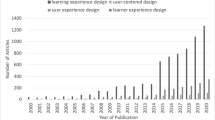Abstract
An exploration of values and perspectives embodied in designed artifacts was conducted via the analysis of two artifacts: Mathemagics-Mental Math Tricks™ and Photomath™. Two frameworks were used for the analysis, first principles of instruction and interaction criticism, in order to identify points at which similar and different value positions and specific perspectives may have been in play during design. Authors discuss informed impressions of the professional values in play for the artifacts’ designers, presumably absorbed from the fields in which they practice and manifest in the artifacts they have produced, and call for exploration of such values across related fields of design to enrich practice in both.
Access this chapter
Tax calculation will be finalised at checkout
Purchases are for personal use only
Similar content being viewed by others
References
Bardzell, J. (2011). Interaction criticism: An introduction to the practice. Interacting with Computers, 23(6), 604–621. https://doi.org/10.1016/j.intcom.2011.07.001
Boling, E., Alangari, H., Hajdu, I., Guo, M., Gyabak, K., Khlaif, Z., et al. (2017). Core judgments of instructional designers in practice. Performance Improvement Quarterly, 30(3), 199–219. https://doi.org/10.1002/piq.21250
Bucciarelli, L. (2002). Between thought and object in engineering design. Design Studies, 23(3), 219–231.
Carter, P. (1999). Mies van der Rohe at work. London, UK: Phaidon Press.
Cross, N. (2007). Designerly ways of knowing. Basel, Switzerland: Birkhäuser.
Cuff, D. (1991). Architecture: The story of practice. Cambridge, MA: MIT Press.
Fleming, D. (1998). Design talk: Constructing the object in studio conversations. Design Issues, 14(2), 41–62.
Goel, V. (1995). Sketches of thought. Boston, MA: The MIT Press.
Hey, J. H. G., Joyce, C. K., & Beckman, S. L. (2007). Framing innovation: Negotiating shared frames during early design phases. Journal of Design Research, 6(1/2), 79. https://doi.org/10.1504/JDR.2007.015564
Kilgore, W. (2016, June 20). UX to LX: The rise of learner experience design - EdSurge news. Retrieved May 31, 2019, from EdSurge website: https://www.edsurge.com/news/2016-06-20-ux-to-lx-the-rise-of-learner-experience-design.
Klemp, K., & Ueki-Polet, K. (2015). Less and more: The design ethos of Dieter Rams. New York, NY: Gestalten.
Kolko, J. (2018). The divisiveness of design thinking. interactions, 25(3), 28-34.
Kries, M., Klein, K., & Clarke, A. (2018). Victor Papanek; The politics of design. Weil am Rhein, Germany: Vitra Design Museum.
Lidwell, W., & Manacsa, G. (2009). Deconstructing design: Exploring the form, function, usability, sustainability, and commercial success of 100 amazing products. Beverly, MA: Rockport Publishers.
Merrill, D. (2002). First principles of instruction. Educational Technology Research and Development, 50(3), 43–59.
Merrill, D., Barclay, M., & van Schaak, A. (2008). Prescriptive principles for instructional design. In M. Spector, D. Merrill, J. van Merrienboer, & M. Driscoll (Eds.), Handbook of research on educational communications and technology (pp. 173–184). New York, NY.
Müller, R. & Thoring, K. (2010). A typology of design knowledge: A theoretical framework. Americas conference on information systems (AMCIS) 2010 proceedings; paper 300.
Nelson, H., & Stolterman, E. (2012). The design way: Intentional change in an unpredictable world. Cambridge, MA: The MIT Press.
Olson, G., Olson, J., Carter, M., & Storrøsten, M. (1992). Small group design meetings: An analysis of collaboration. Journal of Human-Computer Interaction, 7(4), 347–374.
Ragan, T. J., & Smith, P. L. (2004). Conditions Theory and Models for Designing Instruction.
Reigeluth, C. M., & Carr-Chellmann, A. (2009). Instructional-design theories and models, volume III: Building a common knowledge base. New York, NY: Routledge.
Smith, K.M. & Boling, E. (2009). What do we make of design? Design as a concept in educational technology. Educational Technology, July/August, 2009.
Waters, S. H., & Gibbons, A. S. (2004). Design languages, notation systems, and instructional technology: A case study. Educational Technology Research and Development, 52(2), 57–68. https://doi.org/10.1007/BF02504839
Author information
Authors and Affiliations
Corresponding author
Editor information
Editors and Affiliations
Rights and permissions
Copyright information
© 2021 Association for Educational Communications and Technology (AECT)
About this chapter
Cite this chapter
Boling, E., Gray, C.M. (2021). Instructional Design and User Experience Design: Values and Perspectives Examined Through Artifact Analysis. In: Hokanson, B., Exter, M., Grincewicz, A., Schmidt, M., Tawfik, A.A. (eds) Intersections Across Disciplines. Educational Communications and Technology: Issues and Innovations. Springer, Cham. https://doi.org/10.1007/978-3-030-53875-0_8
Download citation
DOI: https://doi.org/10.1007/978-3-030-53875-0_8
Published:
Publisher Name: Springer, Cham
Print ISBN: 978-3-030-53874-3
Online ISBN: 978-3-030-53875-0
eBook Packages: EducationEducation (R0)




